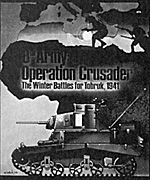
Designed by Frank A.
Chadwick
Developed by Winston
Hamilton
Game Designers Workshop
PO Box 646, Bloomington, IL
61701
Release Date: April, 1984
Catalog No. 474
Price $10.00
Complexity Intermediate
Solitaire Suitability: Low
Rating: *****
I love this game! it is simple to play but offers both sides complex problems in planning and strategy The authors have picked the perfect situation for a double-blind game. And the rules are easv to learn and use.
8th Army: Operation Crusader is an operational level, double-blind simulation of the Crusader Battles around Tobruk in 1941. The units represent battalions, regiments, and brigades. The mapsheet covers the area from the Halfaya Pass in the east to Tobruk in the west.
The most prominent feature of 8th Army: Operation Crusader is a double- blind movement system. There are two identical maps-one for each player-and all positions of "friendly" units are kept hidden from the "enemy." Friendly and enemy territory are delineated by territory markers, which show the front lines on each map. All movement behind one's front line is kept secret, but if a unit attempts to enter enemy territory, the player must identify the hex he's moving into.
If the hex is not occupied, it becomes friendly and remains friendly until the enemy player moves into the same hex. If that hex is occupied by an enemy unit, a battle must be fought. There are no "zones of control," as in other games, but friendly territory prevents retreats and often serves the same purpose.
The counters and mapsheet are adequate and functional. About the only gripe I have with the game is there aren't enough territory markers to handle a really free-wheeling melee, which can often happen in playing 8th Army. Three generic types of units are identified on the counters: armor, infantry, and antitank guns which are easily identifiable. The mapsheet is also functional, if not particularly exciting (how exciting was the Western Desert of North Africa, anyway?)
The rules are reasonably complete and easy to understand. The only problems I had with the rules were cleared up by a phone call to Game Designers' Workshop (GDW) and are presented at the end of this review. I was able to teach two people how to play this game in 20 minutes or less.
No two games of 8th Army ever develop quite the same way. The idea is to out- fox and out-guess your opponent. To accomplish this, you can use many different tactics and strategies. Do the Germans go for Tobruk right away, or do they try to defeat the relieving forces? Do the British opt for a bold stroke at the Tobruk encirclement, or do they try to push up the coast road with their heavier forces in a deliberate manner?
Since you can only discern your opponent's positions from his incursions into your territory and what vou encounter in battles, exact odds can rarely be calculated. As a result, even if your forces are weak, with some daring you can make a successful bluff This game can be played again and again with no repetition of events.
The system used in this game is the simplest way to handle double-blind games I've seen. It could be easily adapted to other situations and really is an advance in the "state of the art" of war gaming.
I've found it takes a long time to play. The "24" hours GDW estimates is extremely optimistic. There are 18 turns in the game, and each unit which enters enemy territory must be moved separately. However, there aren't that many units, so if you wanted to stop a game at a particular point and pick it up later, you can easily record your positions without danger of confusion. it should be noted that both players are involved at all times, and there's very little "down" time for either player in the game.
From what I've read, 8th Army gives an authentic feel of the Crusader Battle, which was one of the most confused of World War II. Despite the relatively simple combat resolution and abstracted airpower rules, the designer has focused on the real problems encountered in a battle of this sort-discerning and countering the enemy's plans while implementing your own. The game is easy to learn, fun to play, and an excellent buy for the money.
8th Army Errata and Explanations:
1) The rules state that "If the defender does retreat from a hex, then all defending ground units must retreat." If a situation develops where some of the units in a hex are prevented from retreating (due to stacking or other restrictions), a partial retreat is allowed. This is the only circumstance in which a partial retreat can be made.
2) The "nationality" referred to in the scrapping rules (13B) is intended to be the color of the counter. It's intended to restrict the Allies, is well as the Axis. For example, Indian units could not be scrapped to bring back South Africans.
3) It's recommended that the setup rules he amended to say the Germans can start "outside of the start line," instead of "North of the Start line."
More Reviews
-
Game Review: RuneQuest
Game Review: Star Trek: The Role Playing Game
Game Review: Toon
Game Review: Battle Above the Earth
Game Review: Paranoia
Game Review: Tsathogghua
Game Review: South Mountain (ACW)
Game Review: Shiloh (ACW)
Game Review: Third World War
Game Review: Boots and Saddles ('80s Air Cav)
Game Review: Axis and Allies (WWII)
Game Review: 8th Army: Operation Crusader
Game Review: James Clavell's Shogun
Game Review: King Hamlet
Game Review: Grass
Game Review: Hack 'N' Slash
Back to Table of Contents -- Game News #1
To Game News List of Issues
To MagWeb Master Magazine List
© Copyright 1999 by Dana Lombardy.
This article appears in MagWeb (Magazine Web) on the Internet World Wide Web.
Other military history articles and gaming articles are available at http://www.magweb.com